Understanding Console Emulation Master Buss
Console emulation plug-ins are great to bring any mix to life. They allow us to have the sound of big format consoles directly from our computer, and allow us to take advantage of their saturation and non-linearities without channel limitations, maintenance or increase in the electricity bill. Some of them can also improve your workflow by providing full sonic control over your mix, just like you would expect from the master section of an analog console.
Satson and Britson provide the ability to control every single instance of their plug-ins in our session from one single place, allowing you to tweak and adjust levels and saturation in a centralised way. But to better understand why this can improve your workflow, let’s go back in time to when big consoles ruled the studio world.
Buses and VCAs
Consoles can be described as audio signal managing devices. They can receive, move, send and combine signals together, providing individual level control of all of them to adjust the mix to our taste.
When channel numbers are low, consoles are easy to operate, but the moment these values increase, we need a way to group the channels so we end up with more manageable counts. That’s why Busses and VCA groups were created in the master section of a console.
Busses combine signals from different channels and provide control over the summed signal from one single fader. A good example of this is when we send our drums and bass to a group to have volume control of this sub-mix.
On the other hand, no audio passes through a VCA. Instead, they remotely control the volumes of their assigned channels. By moving the VCA fader assigned to the drums, all the drum track volumes will move simultaneously. This will change the balance of our drum and bass from our previous example, which will modify the sub-mix reaching the bus fader.
As you can imagine, the combination of these two types of groupings can be very powerful, especially when mixes become more complex, with more buses, tracks, effects, etc. One could create sub-mixes through buses to narrow down the number of tracks, and then control the entire mix of those buses through a handful of VCAs. All of the sudden the whole track is under one hand control.
Master Buss
Modern DAWs created equivalent types of groups in their mixers so engineers were able to easily transition their workflows into the digital environment. Unfortunately, they lacked the sonic footprint of the classic consoles that gave weight and depth to the tracks. That’s where plug-ins like Britson and Satson come into play.
If you just use the channel instance of these two plugins in your sessions, you are missing many of the benefits that these console emulations can offer to your workflow. By using Buss instances in your Aux tracks, you will be recreating the bus groups of an analog console in your DAW, adding more cohesion to the entire mix. You can also add the Buss instance in your Master track to emulate the effect of having the full mix going through the main mix channel of a console — but why stop there?
In a previous post, we saw how the Buss instance of Britson or Satson can turn into a Master Buss. This provides full control of our mix from one single plug-in. By enabling Grouping in our Buss menu, you will access the equivalent of 8 VCA channels in your plug-in window. From here you can trim the channels or buses assigned to each group. You can also engage or disengage their saturation or FAT mode and even turn the trim fader into a drive knob.
Grouping is great for those who like to tweak their mixes from one single place, and it is especially effective if Britson or Satson is used as the final insert on every track. This is because any changes in the Master Buss will modify the levels and saturation of each plug-in instance, without affecting the gain staging and processing of the tracks themselves.
Thanks to Sonimus’ console emulations, everybody can benefit from the sound and workflow of an analog console, bringing the sonic qualities and control features that everybody loved from big format consoles straight into your DAW.








RE: One Plug-In To Rule Them All! 💯 Can you guess it❓Sure; the new Console Emu is API (hint was in the API desk in the previous blog and is an obvious contender) and then there will be a new plugin which can switch between the 3! Looking forward to it! :-) :-)